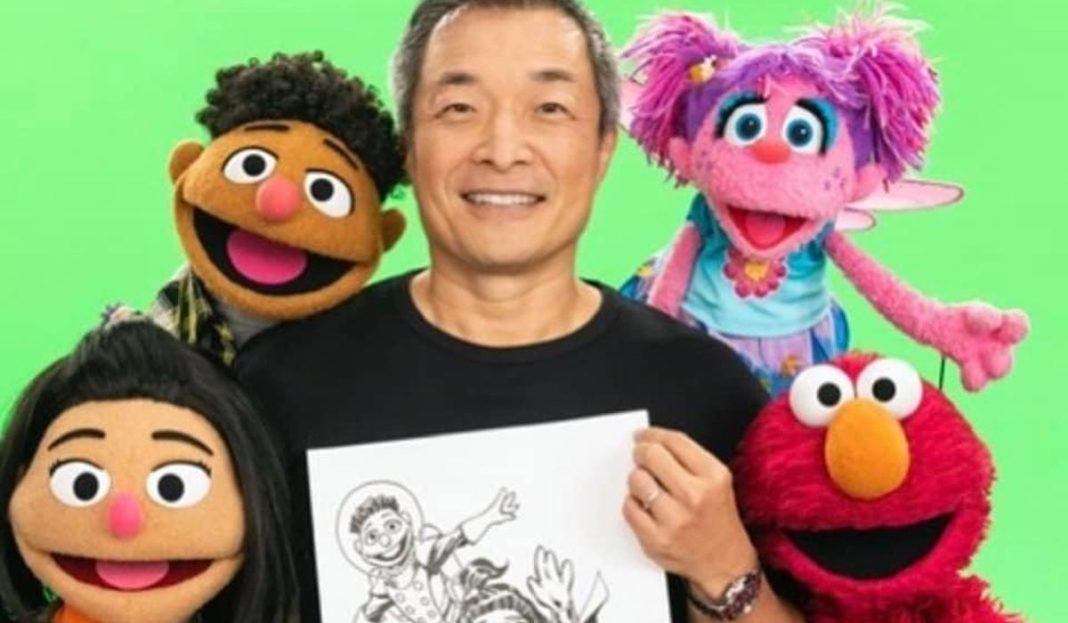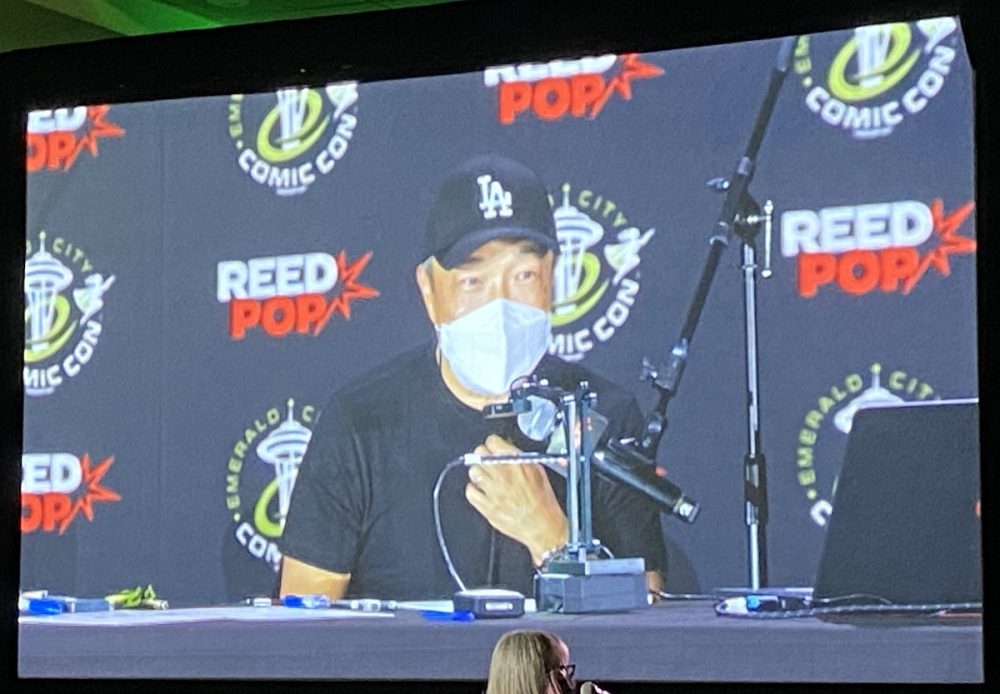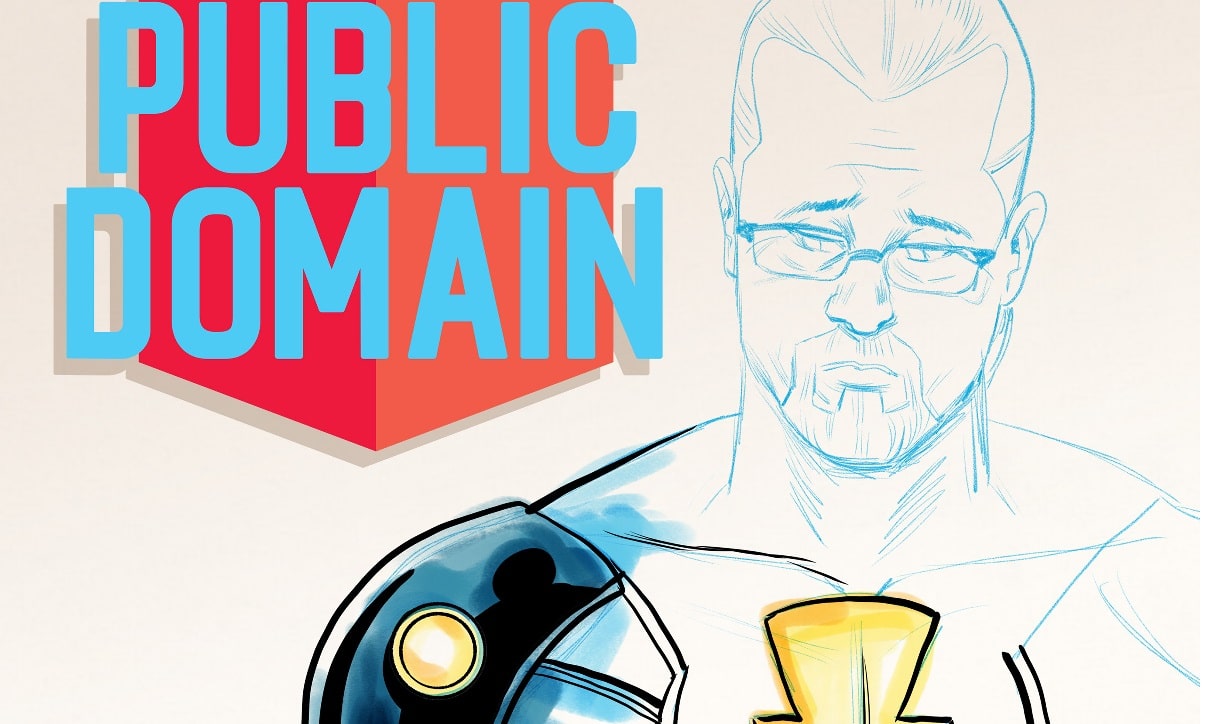One of the featured guests at this year’s Emerald City Comic Con was legendary artist and current DC Comics publisher & chief creative officer Jim Lee. On the final day of the convention Lee took to the main stage in the Sheraton Ballroom for a moderator-free spotlight panel that featured Lee drawing and giving away sketches, and talking about his life and career, including an in-depth look at his recent appearance on Sesame Street.
Lee sketched on-stage for a few minutes before kicking things off by thanking people for attending. The artist said he felt somewhat anxious returning to in-person cons after so much time off, and he thanks the crowd for helping him ease back into them. Throughout the discussion Lee plugged his Twitch stream, which he started during the pandemic as a way to stay connected with fans while at home.
Lee briefly covered his history for the two newcomers in the crowd who didn’t know who he is, from Marvel to Image to DC. Going backward in time, Lee spoke about his birth in Seoul, South Korea, and how his family moved to Ohio after his father, who was a doctor, got a job in the states due to a shortage of medical professionals. He talked about being sent home by a teacher on his first day of school because he didn’t speak any English, and said that he learned English from comic books, having gotten into Superman after watching the Max Fleischer cartoons in Korean as a child.
Along with comics, Lee said that Sesame Street also inspired him to learn English (especially since his parents kept throwing away his comic book collection). His parents let him watch that show as much as he wanted, so being invited to help introduce Ji-Young, the new Asian-American Muppet, to the show earlier this year was very meaningful for Lee. He said his mother also learned English from Sesame Street, and that his parents were the most proud of him for appearing on that show than they’d ever been before during his career, even if they still wish he’d become a doctor.
An audience member asked how Lee met his long-time inker Scott Williams. Lee joked that Williams is the person who has been with him the longest in his life, as they’ve worked together since 1987. Whilce Portacio was Lee’s inker on his first Marvel comic, an issue of Alpha Flight (#51), and Lee spoke about calling Portacio and having a three-hour conversation with him. Portacio invited Lee to San Diego Comic Con that year to hang out with he and Scott Williams, and Lee described his own work at the time as “good enough to get hired,” but nothing special. He said he had been a big fan of Williams before they met, and after as his pencilling improved Williams inked an issue of Punisher War Journal that he drew, at which point Lee felt like his work finally looked the way he had always wanted it to look. Once he started work on Uncanny X-Men, Lee requested Williams to ink him, and after the editors liked their work they continued to work together. He described Williams and colorist Alex Sinclair as being like family to him, and said there’s “no stress” in their collaboration.
Another fan asked about what Muppets Lee met while working on Sesame Street. Along with new Muppet Ji-Young, Lee said he met Elmo, Abby Cadabby, human actor Alan, and Big Bird, who gave him a feather from their body. He said being on the show was just his second acting gig ever, after what he described as a terrible appearance an episode of Bob, the Bob Newhart sitcom where Newhart played a comic book artist. He talked about acting in the scene without having rehearsed ahead of time, and that the thousands of pieces of tape on the stage floor threw him off immediately. His sole line was “Hey, how’s it going?”, which he said was the only thing they trusted him to say.
On Sesame Street, Lee said he memorized his own lines but not those of his fellow actors, which he realized the night before filming meant he would have no idea when to say his lines. His wife helped him learn the dialogue while he worked on an illustration for the show, which he said was more difficult than he’d expected. Lee finished the artwork for the show at 5AM, with producers coming to pick him up at 8AM.
Lee revealed that he hadn’t finished the art earlier because, before flying from LA to the east coast to appear on the show, he tested positive at home for COVID. His wife tested negative, and afterward the two spent hours that he would have used to draw driving around searching for more at-home tests to confirm his diagnosis. After four additional home tests Lee tested negative, and eventually he heard from the test manufacturers that the specific batch of tests he’d used initially had been found to return false positive results.
Lee described rehearsing with the puppeteers, who move around on the ground on dollies, and how different it was when they put the Muppets on their hands. Lee said if you watch closely you can see him reading lines off of the puppeteers’ teleprompters, which are down on the floor. Asked to sing on the show, Lee said he is a terrible singer, which he blames on having been hit by a truck as a kid in Korea. He joked that it was a Daredevil-like situation where being hit by that truck made him lose his ability to sing but gain the ability to draw really well.
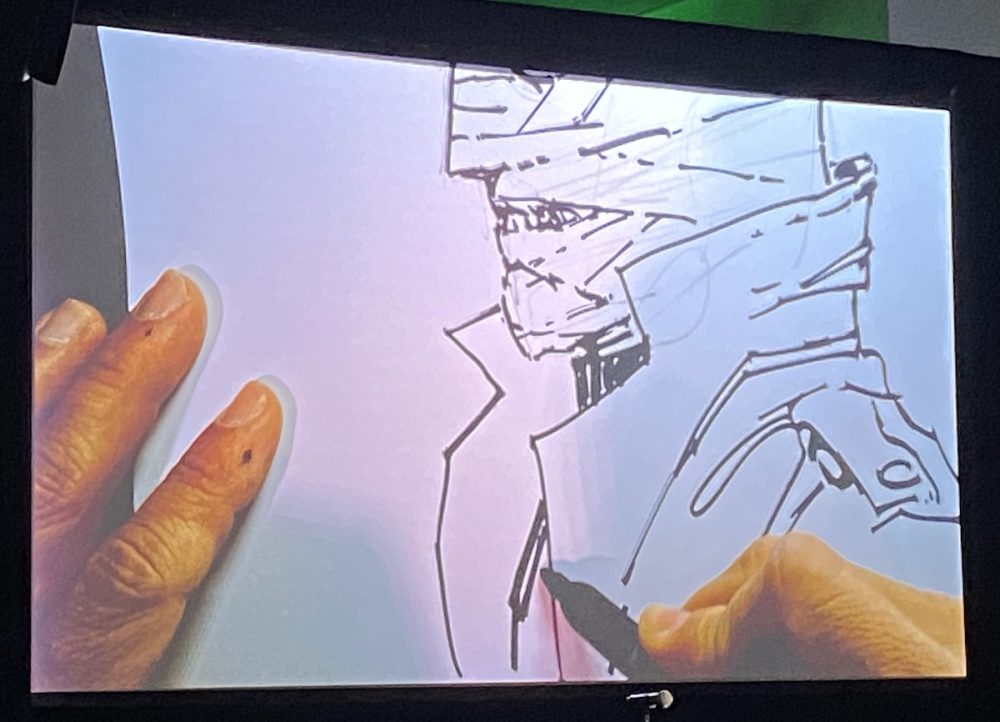
Another fan asked Lee about his work on Hush, in particular how he interpreted the existing characters and developed Hush with Jeph Loeb. Lee said creating Hush was a request from Paul Levitz, who asked him to add something new to the Batman toy chest. He said Loeb took the name ‘Hush’ from a lullaby, and that they toyed with operatic visuals a la Phantom of the Opera, but that once he became a surgeon Lee started thinking about the bandages, which he joked he lifted from The Unknown Soldier and Negative Man. The trench coat was included because, Lee quipped, “That’s my thing, trench coats.” He also talked about bringing Jason Todd into the story, which he said he and Loeb came up with on the fly while working on the series, and incorporating the Robin elements into the Hush suit.
An audience member asked Lee to talk more about his parents and how they feel about what he’s done with his life. Lee said his parents left Korea “with a specific vision of what their lives were going to be,” and that they had a clear path for him, so it was hard for them to see him stray from that. He spoke about how neither of them knew what a comic book artist does before he started out. He did stress that they’re happy with him as long as he’s happy.
Asked about his influences, Lee described a time when a third-grade teacher caught him drawing the Marvel character Nighthawk during class. The teacher snatched the drawing from him and crumpled it up before stopping, uncrumpling and looking at it, and deciding to hang it on their bulletin board. Other influences Lee spoke about included an art teacher who suggested that he pursue a career in art, even if he wasn’t comfortable in the fine art world. After graduating from college Lee said he finally sat down and forced himself to draw interior pages. Archie Goodwin and Carl Potts were also big influences after he was discovered at a convention.
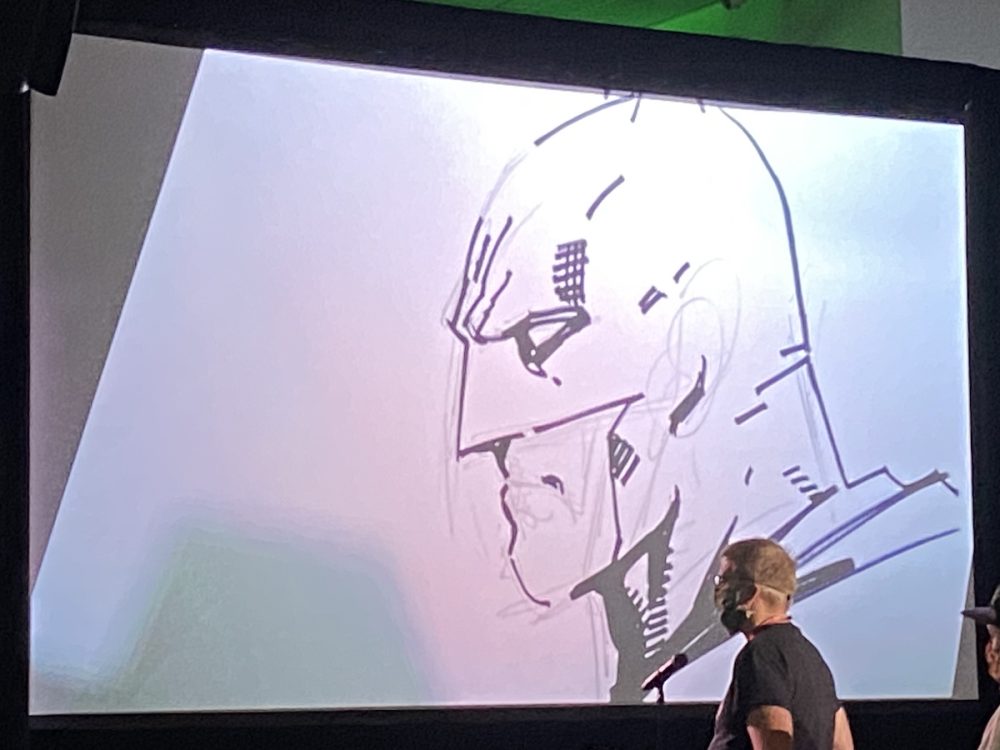
Discussing the foundation of Image Comics, Lee said he felt like, at the time, “the industry was going through a change without realizing it was going through a change,” and that the root of Image was the role the creator plays in the booming success of the industry. The forming of Image came down to creative issues and compensation issues the founders had with the Big 2, but also, Lee said, the way things were at Marvel and DC at the time made it such that they couldn’t adapt as quickly as they needed to to keep up with the overall landscape of comics, not just in terms of compensation but also in quality. Lee added that some of the changes as a result of the formation of Image are still evident in the industry today.
Lee said he’s visited Korea a handful of times as an adult. His daughter goes to school there, which Lee joked was because of her love of K-Pop. After Lee’s parents moved to the U.S. the rest of the family followed, so his daughter is the only member of his family over in Korea right now, and he expects her to put down roots there eventually.
Asked if there’s anything Marvel is doing that Lee really admires, including added diversity among its characters, Lee said he’s definitely a fan of things other publishers are doing, and that “a rising tide lifts all boats.” He said representation is important as a reflection of the world we live in. Growing up Lee said he was “used to being different,” and that he had no expectation that content would be created for him, but that when he did see Asian representation in American media it was embarrassing. He described how seeing the world through his kids’ eyes in terms of characters and cosplay opportunities and fandom has been a gift. “It’s not about eradicating the past,” he added, “it’s about building on the past and expanding the universe.”
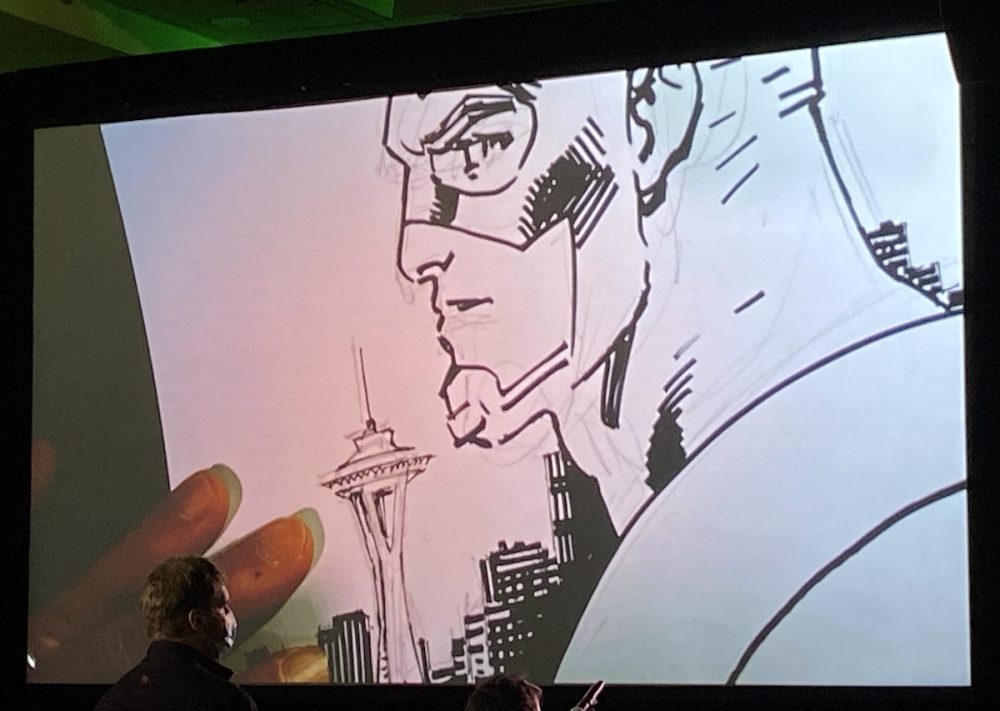
Speaking about his X-Men work, Lee said he had wanted to work on stories in the X-universe with elements that had made a difference to him as a kid. He specifically mentioned the Savage Land as an area that he wanted to explore, as well as The Brood and the Shi’ar Empire. The only issue that wasn’t on his X-Men wish list was Uncanny X-Men #268, which he said came about because of a conversation with Chris Claremont. Lee joked that he had hoped to find out Wolverine’s origin from the writer, and when Claremont asked him what he wanted to work on, X-related or otherwise, Black Widow, Captain America, and a story set during World War II were the things Lee listed. Claremont came up with the story for that issue based on their conversation, and Lee said Claremont tried to get Bob Harras to make it a two-part story but was shot down.
With that, Lee gave away the final sketch to a woman with a set of nail clippers (previous sketches had gone to people with a specific vaccination date, and a Taco Bell receipt), and the panel ended.
Miss any of our other ECCC ‘21 coverage? Find it all here!


